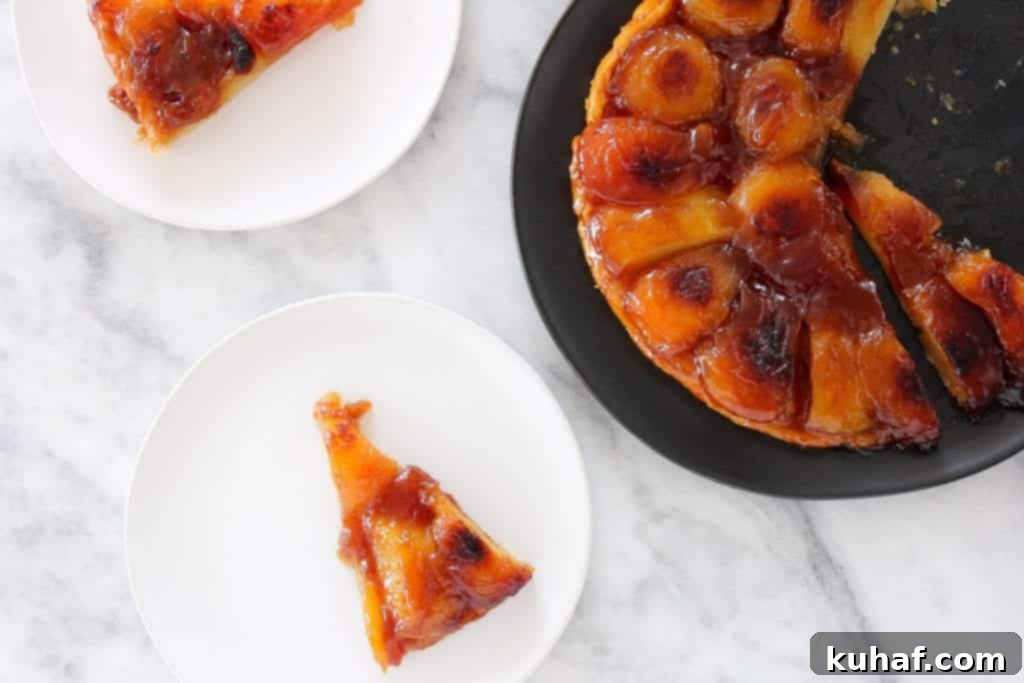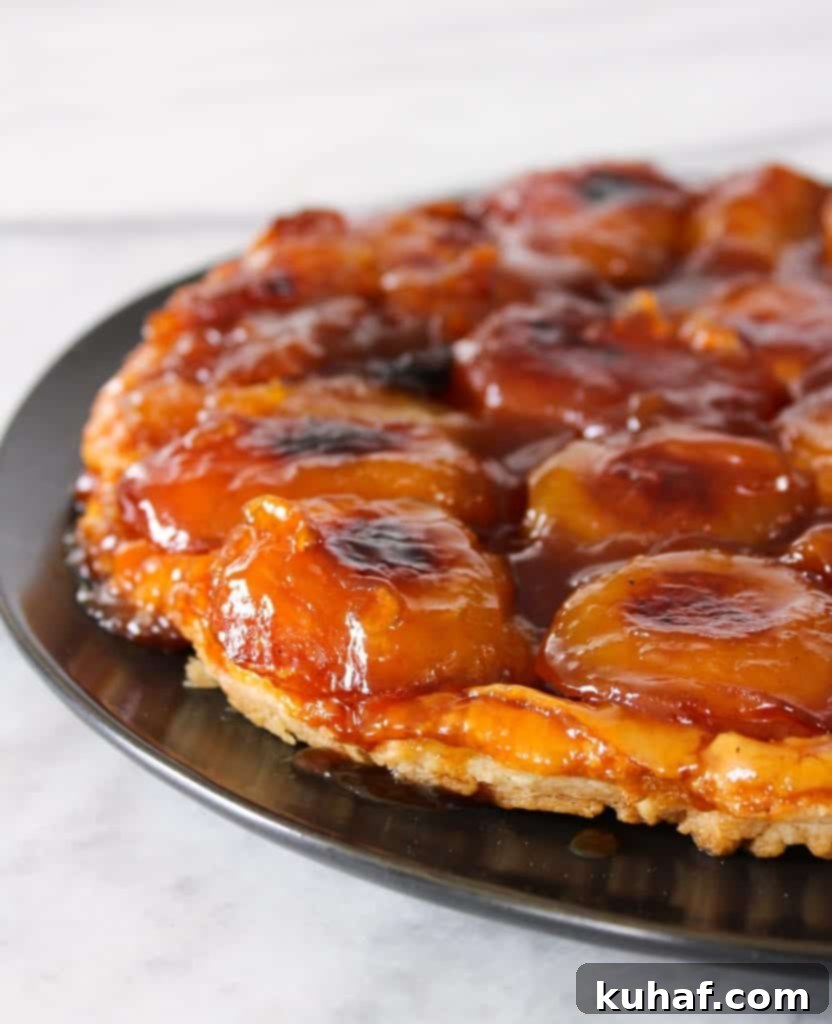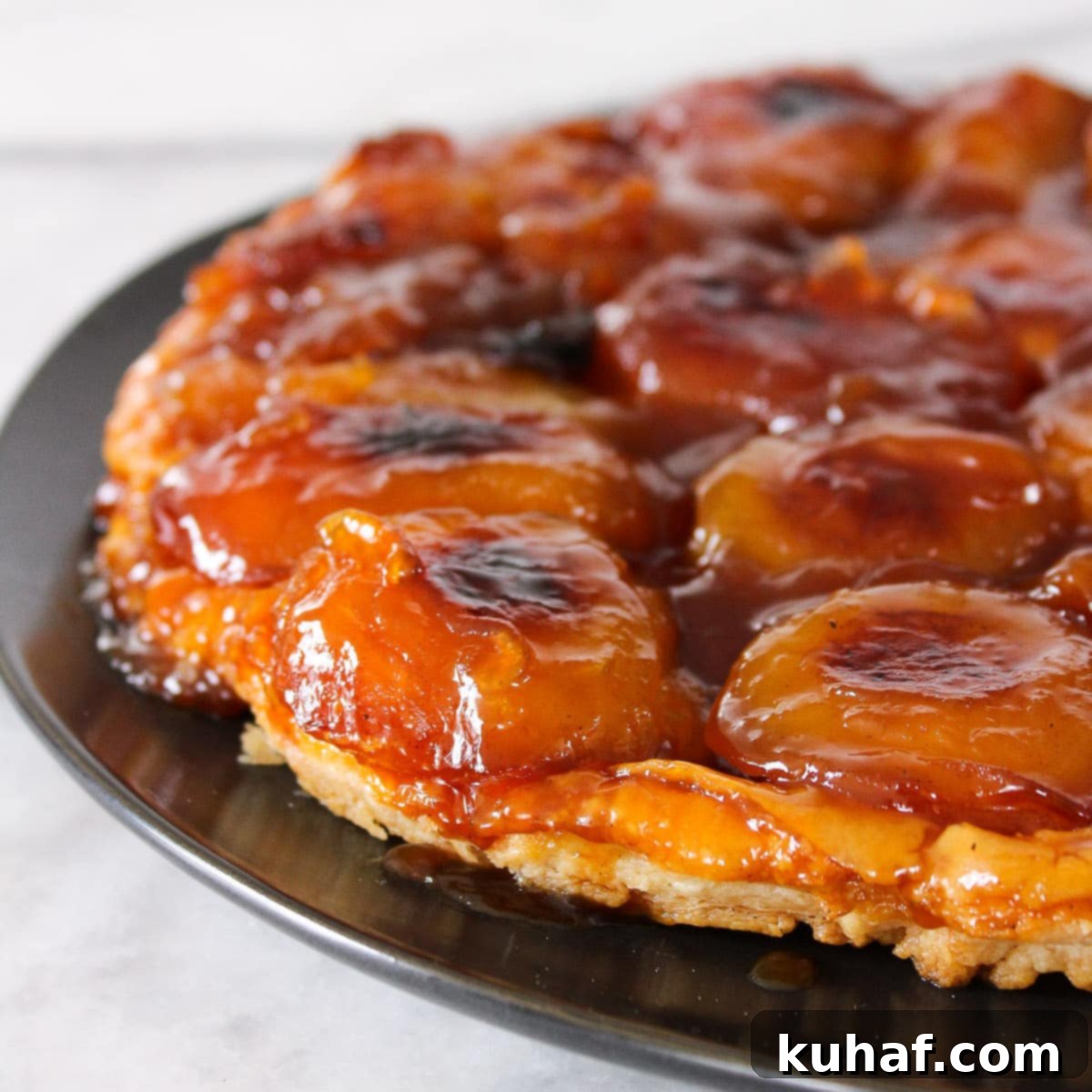The Ultimate Apple Tarte Tatin Recipe: A Guide to French Caramel Apple Perfection
This Apple Tarte Tatin is more than just a dessert; it’s a culinary masterpiece that embodies the essence of French patisserie. For those who dream of Parisian cafes and exquisite flavors, this tarte is the answer. Imagine tender, deeply caramelized apples, nestled beneath a blanket of golden, impossibly buttery puff pastry, all brought together with a touch of theatrical flambé. It’s an experience that tantalizes the taste buds and captivates the senses, proving that sometimes, simplicity truly is the key to extraordinary indulgence.

In many parts of the world, especially America, the humble yet elegant Apple Tarte Tatin often finds itself overshadowed by its more boisterous cousin, the classic apple pie. But I am here to passionately argue that this French beauty deserves every bit as much—if not more—attention. Let me present a compelling case for why the Apple Tarte Tatin should be your next baking endeavor. Prepare to be convinced!
Why Apple Tarte Tatin Reigns Supreme: A French Dessert Masterpiece
- The Unbeatable Duo: Caramel and Apples. This combination is legendary for a reason. The Tarte Tatin takes sweet, juicy apples and transforms them into a deep, rich, sticky caramel delight. It’s the original “caramel apple” dessert, elevated to an art form, offering a depth of flavor that a simple apple pie often struggles to achieve. The interplay of the slightly tart apples with the intensely sweet and complex caramel is pure magic, creating a flavor profile that is both comforting and sophisticated.
- A Taste of France, Anytime. There’s an undeniable allure to French cuisine, a certain je ne sais quoi that transports you. Crafting an authentic Apple Tarte Tatin brings a piece of that sophisticated French charm right into your kitchen. It’s a delightful way to indulge your inner Francophile, offering a culinary escape even if a trip to the cobbled streets of Paris isn’t on the cards right now. The simple elegance of this dessert is quintessentially French.
- Deceptively Simple Elegance. Despite its stunning, gourmet appearance, the Apple Tarte Tatin is surprisingly straightforward to make. In my professional opinion, having made countless apple pies, it’s significantly simpler and less fussy. You’re essentially building it upside down, which means the presentation takes care of itself. This makes it an accessible dessert for home bakers who want to impress without being overwhelmed by complicated techniques, especially if you opt for quality store-bought puff pastry – a little secret many professional bakers embrace for convenience without sacrificing quality. We’ll delve into puff pastry later!
- One Pan Wonder. Yes, you read that right! This entire glorious dessert is cooked in a single oven-safe skillet, typically a cast-iron pan. This not only simplifies the cooking process but also makes cleanup a breeze, a detail every home cook can appreciate. Less washing, more enjoying, and certainly a more efficient use of your kitchen time compared to multi-pan pie recipes.
- Speedy Satisfaction. Compared to the multi-step process of preparing a traditional apple pie, which often involves making pie crust from scratch, peeling and slicing numerous apples, and a longer baking time, a Tarte Tatin can be ready to bake in a fraction of the time. With just 15 minutes of prep and 25 minutes of cook time, it’s an ideal dessert for last-minute gatherings or when you crave something extraordinary without spending hours in the kitchen.
- The Grand Finale: The Show-Stopping Flip! Just like my beloved crème caramel, the Tarte Tatin offers a dramatic flourish when it’s time to serve. The moment you carefully invert the skillet onto a serving plate, revealing the perfectly golden, caramelized apples and crisp pastry, is pure showmanship. It’s a guaranteed showstopper that will earn you admiring gasps and applause from your guests, making it a dessert that’s as much about the experience as it is about the taste!
Et voilà! A dessert that not only tastes incredible but also creates an unforgettable moment. It’s truly a testament to the beauty and efficiency of French culinary tradition.

My Tarte Tatin Journey: From Skeptic to Enthusiast
My initial encounters with Tarte Tatin weren’t particularly inspiring. During my culinary school days, and even later while exploring countless French bistros and cafes in Paris, I was often left unimpressed. Many a tarte tatin presented itself as mealy, overcooked, under-caramelized, or, worst of all, with a soggy bottom. These experiences led me to believe that this iconic dessert was often misunderstood or poorly executed, and I honestly questioned its lauded status.
But then, through dedication and experimentation, I found *this* recipe. This version, refined through years of professional experience and a deep understanding of French pastry techniques, is a true game-changer. It’s the kind of Tarte Tatin that makes you understand why it’s so revered across the globe. We’re talking deep, rich, complex caramel that’s perfectly balanced with a hint of bitterness to offset the sweetness, apples that retain a slight bite yet are meltingly tender and infused with flavor, and a puff pastry that is supremely buttery, golden, and flaky. Every single element comes together in perfect harmony, creating a dessert that is nothing short of a stunner. The gangs all here, and it’s spectacular!
Achieving Apple Tarte Tatin Success: Expert Tips for a Flawless Dessert
Creating a truly exceptional Apple Tarte Tatin requires attention to a few key details. Master these, and you’ll consistently produce a dessert that’s worthy of any French patisserie, impressing even the most discerning palates.
-
Choose Your Apples Wisely: The Foundation of Flavor and Texture
The success of your Tarte Tatin hinges almost entirely on your apple selection. Unlike apple pie, where apples are often gently cooked and can afford to be a bit softer, here they undergo a much more intense and prolonged caramelization process. Therefore, you need firm, fresh apples that can hold their shape and texture without turning mushy or mealy under the heat. Varieties like Granny Smith (for a classic tartness), Honeycrisp, Gala, Crispin, Crimson Crisp, or Ginger Gold are excellent choices. Avoid apples known for becoming mealy, such as Macintosh, as they will simply disintegrate into an unappetizing puree within the caramel. I also strongly lean towards slightly tart apples. The natural acidity in tart apples provides a crucial counterpoint to the intense sweetness of the caramel, creating a more balanced, nuanced, and utterly delicious flavor profile that prevents the dessert from being cloyingly sweet.
-
Puff Pastry Perfection: Keep it Cold and Preserve Layers
All the golden rules of working with puff pastry apply here, but the most crucial is to keep it COLD! Puff pastry’s signature ethereal flakiness comes from countless thin layers of butter separated by delicate dough. When baked, the water in the butter rapidly turns to steam, which dramatically pushes these layers apart, creating that desirable airy, flaky texture. If the pastry gets too warm, the butter melts prematurely and incorporates into the dough, compromising the distinct layers and resulting in a less airy, less flaky, and potentially tough crust. You’ll face an additional challenge: placing cold puff pastry over cooked, caramel-coated apples. Patience is key. It is absolutely vital to allow the caramelized apples to cool completely to room temperature before topping them with the cold puff pastry. Placing cold pastry on hot apples will cause the butter to melt immediately, defeating the purpose of those delicate layers and leading to a greasy, dense crust. Work swiftly, and don’t be afraid to pop the pastry back into the fridge for a few minutes if it starts to feel too warm or sticky while you’re handling it.
For those aspiring to truly elevate their baking, making your own puff pastry is a rewarding endeavor. The depth of flavor and texture achieved is unparalleled. I offer recipes for both Inverse Puff Pastry and Classic Puff Pastry. Homemade puff pastry can be prepared ahead of time, frozen in sheets, and then thawed when needed for ultimate convenience—just as you’ll see me do in the accompanying video. If you do make your own, consider adding a pinch of a custom apple pie spice (without cardamom) directly into the dough for an extra layer of warm, aromatic flavor that perfectly complements the apples and caramel.
-
The Right Pan: Cast Iron for Superior Caramelization
While any heavy-bottomed, oven-safe skillet can technically work, a cast-iron skillet is highly recommended for an optimal Tarte Tatin. Cast iron excels at retaining and distributing heat evenly across its surface, which is crucial for achieving a perfectly uniform caramel and a beautifully golden crust on your apples. The consistent, gentle heat ensures that the sugar caramelizes consistently across the entire surface, preventing undesirable burnt spots or areas where the caramel is too pale and lacks depth. Furthermore, cast iron helps the tart release cleanly when inverted. High-quality brands like All-Clad also offer excellent heavy-bottomed, oven-safe options if cast iron isn’t available, providing similar benefits in heat distribution.
-
Fresh is Best: Enjoy it the Day it’s Made
I understand the temptation to make desserts ahead of time, especially for entertaining, but for the Apple Tarte Tatin, it truly shines on the day it’s made. The puff pastry is at its crispiest, and the caramel and apples are at their peak flavor and texture, offering that perfect balance of tender fruit and buttery crunch. Don’t let this deter you from making it; the recipe is straightforward enough that you can easily prepare and bake it closer to serving time. To streamline the process, adopt a “mise en place” approach: have all your ingredients prepped, measured, and ready to go. This will make the actual cooking incredibly fast, allowing you to surprise and delight your family and friends with your fresh French pastry skills without feeling rushed.
-
Mastering the Caramel: Don’t Be Afraid of the Dark
This is perhaps the most critical step for developing the rich, complex flavor that defines a truly great Tarte Tatin. Your caramel needs to be taken to a medium amber color. Many home cooks are hesitant to let their sugar get this dark, fearing it will burn. However, a pale, light-colored caramel will result in a Tarte Tatin that is simply sweet, lacking the profound depth, slight bitterness, and nutty complexity that defines a truly great caramelized apple dessert. Keep a close eye on it, swirling the pan gently if needed to ensure even cooking, and remove it from the heat once it reaches that beautiful, rich amber hue, just before it turns dark brown. It’s the difference between a good dessert and an unforgettable, restaurant-quality one.
-
The Flambé: A Touch of Theater and Flavor Depth
While the flambé step isn’t strictly required for the structural success of your Tarte Tatin, it’s a fantastic addition for both showmanship and a subtle, complex depth of flavor. The controlled burning off of alcohol adds a delicate, almost smoky nuance that beautifully complements the apples and caramel. I typically use apple brandy, which naturally enhances the apple notes, but traditional brandy, Cointreau (for an orange citrus lift), or Calvados (another delicious apple-based brandy) are also excellent choices. Always exercise extreme caution when flambéing: ensure good ventilation in your kitchen, keep flammable items (like paper towels or curtains) well away from the pan, and use a long-handled lighter or kitchen torch to ignite the alcohol safely. The flame will subside naturally once all the alcohol has burned off, leaving behind only the delicious essence and a memorable presentation.
Ready to Bake Your Own Apple Tarte Tatin?
With these expert tips in mind, you’re well-equipped to create a show-stopping Apple Tarte Tatin that will transport you straight to a quaint French patisserie. The recipe below provides all the precise measurements and step-by-step instructions you’ll need. Gather your ingredients, prepare your trusty skillet, and get ready to impress with this classic French delight. Your culinary adventure awaits!

Apple Tarte Tatin
Pin Recipe
Comment
Print Recipe
Ingredients
- 5 apples
- 45 g unsalted butter
- 230 g sugar
- 1 pinch kosher salt
- 1 pinch ground cinnamon optional
- 30 g apple brandy optional
- 1 sheet cold puff pastry classic puff pastry, inverse puff pastry
Instructions
-
Peel and core all the apples. Slice in half from the top to bottom (not around the circumference). Slice in half again. I find it is easier to fit more apples into the pan when they are cut into quarters like this.
-
Melt the butter in an 8-10 inch skillet. You can make this same recipe in a 12 inch skillet but add at least one more apple.
-
Arrange apples with the outside (round part) facing down into the pan. Make sure to crowd them to cover the whole bottom. As they cook they will shrink and you don’t want to find yourself with bare spots!
-
Pour sugar over the top of the apples in the pan along with the pinch of kosher salt and pinch of cinnamon if desired. On medium heat allow the sugar to caramelize, swirling if needed, and rotating the pan to make sure the caramel is even all the way around. Take the caramel to a medium amber.
-
Flambée! Add the alcohol on top of the caramelized apples. Light on fire using a gas burner, kitchen torch or lighter. Allow the alcohol to burn off completely (no flame means no more alcohol).
-
Remove from heat and allow to cool to room temperature.
-
Preheat oven to 375°F.
-
Cut puff pastry sheet to be just slightly larger than your pan. Place on top of apples, rolling in the sides if they are slightly too large.
-
Bake in preheated oven 20-30 minutes or until the puff pastry is puffed and golden brown.
-
Allow to cool about 10 minutes in the pan before carefully flipping it onto a large plate or serving dish. I find it easier to cut pretty slices when it is hot, so I usually cut mine ahead of time with a sharp knife.
-
Serve the day it is made!
Video
Notes
Flavor Tips – It’s all in apples: choose your apples wisely because they are going to be cooked far more intensely than in an apple pie. You want to choose firm, fresh apples that don’t have a tendency to get mealy (I’m lookin’ at you, Macintosh?). I also prefer apples that are on the tart side because of all the caramel they are going to be hanging with. Think Honeycrisp, gala, crispin, crimson crisp, or ginger gold.
Technique – All the rules of Puff apply, but mainly keep it cold! You have the additional challenge of putting cold puff on cooked caramel apples, so just be patient. It is important to wait until the apples cool to room temperature before adding the puff and baking. Preserve the layers!
Helpful Tools – It is made in one dish! A cast-iron skillet will give you a more even caramel and a better-looking tarte but any heavy-bottomed skillet will do. All-Clad works well.
Variations – You could add some warming spices based on your preferences! Homemade Apple Pie Spice Mix would be lovely!
Storage – It is best the day it’s made. I know, I know. I promise that it is easy enough that you can pull it off at the last minute! Have everything ready and wow your family and friends with your French pastry skills. Store cooled Tarte Tatin in an airtight container or tightly wrapped in the fridge for up to 3 days…be aware that the puff pastry will lose crispness, but the taste will still be there!
Nutrition
Before You Go!
I sincerely hope you’ve been inspired by this professional chef-tested recipe and the detailed insights into crafting a perfect Apple Tarte Tatin. This dessert is a true labor of love, but one that is incredibly rewarding. Don’t hesitate to dive into the world of French baking; the results are always worth the effort and will undoubtedly become a favorite in your repertoire!
If you’ve enjoyed mastering this classic, be sure to explore our other delicious, chef-developed tart recipes for more culinary adventures. Or, if you’re still on an apple kick, why not try my comforting apple cobbler recipe? Happy baking, and bon appétit!
